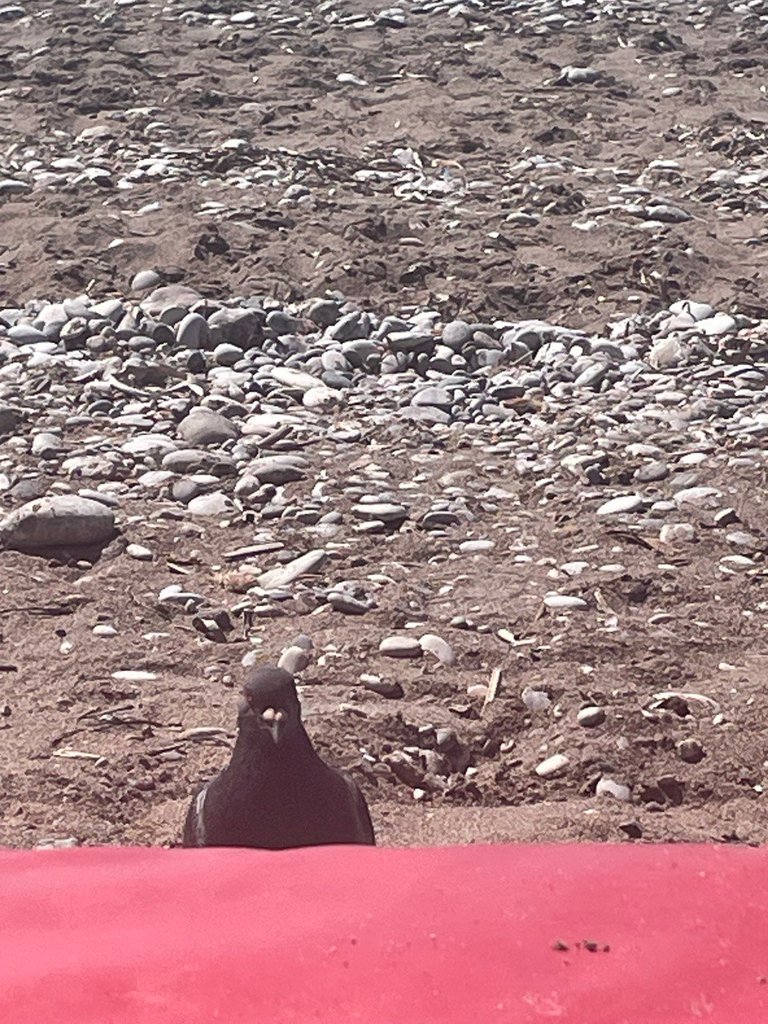
So my Girlfriend was on vacation in Greece and was enjoying her time there, but suddenly this cute little befeathered friend popped up just next to her. So I thought I'd spread some knowledge about 'em here.
I have no idea what happened afterwards, but I want you all to know that Pigeons can be very cute and quirky, and at the same time very misunderstood.
Anyway I'm now going to tell you some facts about them from what I've gathered:
There is much fear about them spreading disease, but in reality they are just like any other bird: Just wash your hands after you are done holding them, and unless eating bird poop is part of your diet, you're very unlikely to ever be exposed to any health risks, although they themselves may occassionally get life-threatening diseases, but spreading them onto humans is incredibly unlikely.
What I have learned from them "dancing around", bowing their heads down and cooing means one of two things: 1) They want you to come nest with them, a sort of invitational behavior to their mate 2) It's territorial behavior, to show where their borders go and want to keep their rival pigeons at bay.
These birds have also been present in a lot of wars, but namely World War 1 and have served the Entente as messengers, while avoiding German released Falcons trying to put them down and prevent communication. One of them got shot in the eye and lost one foot, whose name was "Cher Ami" and was stuffed up after its death, and was awarded medals for its bravery, similar to the likes of other animals in the next World War, like Wojtek the Bear.

Source: https://en.wikipedia.org/wiki/Cher_Ami
For although Pigeons were originally seen as very royalty-associated animals, eventually people at some point just got tired of them and threw them out on the streets, and these Pigeons are called Feral Pigeons. They are not inherently wild 100%, which is why they can at times be more tolerant with human presence being near.
Many wild Pigeons protect their babies far away from the visibility of any potential predators, which is why baby Pigeons are rarely seen. They grow up from the point of the Hen and Cock mating, being inside an egg for 18 whole days on average before hatching. They usually grow up to the physical look we are used to seeing them within 45 days, and a few weeks later they usually learn to fly. They dont look very beautiful at first, but overtime they gain more and more feathers and lose their original yellow "hair", because I'm not entirely sure if it's feathers or wings in this stage. The babies go through two stages before maturing, which are known as Hatchling, and Fledgling. They are fed crop milk that either Sex can produce, although it is fed through a natural process (or at least for these birds), called vomiting. It helps them to grow, and they rarely know how to be fed without guidance. The Hens are very protective about their babies, despite not having a very strong defense, they will do everything within their capacity to defend their beloved Children.

Source: https://pigeonwriter.wordpress.com/2008/04/15/about-mommy-and-daddy-pigeon-and-baby-pigeons/
Some people still like to own domesticated Pigeons due to wanting a loyal bird friend, but some of them raise them from as early as day 1 from the egg hatching, which makes them subject to a process known as "imprinting". This makes them feel way more connected to Humans rather than their fellow Pigeons, and will make them a bit funny in their head, will see humans as potential rivals due to seeing themselves as some kind of "mutated" humans too. The imprinting is not recommended, for a Pigeon needs to spend at least the first two weeks around a caring mother to not act like how imprinted ones do, because it can lead them on the wrong path in life.
Finally, Pigeons are known to, according to Hieroglyphs, have been domesticated since at earliest around 5,000 years ago in Mesopotamia according to Hieroglyphs. Due to this inherent process of captive breeding and never-ending domestication, Pigeons are known for being one of the least fearing birds there are, which is why any other bird would've been gone long ago if you walked within 30 meters of them.
Hope you enjoyed this little read on the Domesticus Columbus, this is just the info I know. If you would like to correct me or ask anything else about them, do let me know, I am open to discussion and learning more.
Until next time!
Your content has been voted as a part of Encouragement program. Keep up the good work!
Use Ecency daily to boost your growth on platform!
Support Ecency
Vote for new Proposal
Delegate HP and earn more
Interesting info! I am happy you shared this with Feathered Friends!
Congratulations @schim2! You have completed the following achievement on the Hive blockchain and have been rewarded with new badge(s):
Your next target is to reach 50 upvotes.
You can view your badges on your board and compare yourself to others in the Ranking
If you no longer want to receive notifications, reply to this comment with the word
STOPCheck out the last post from @hivebuzz:
Support the HiveBuzz project. Vote for our proposal!